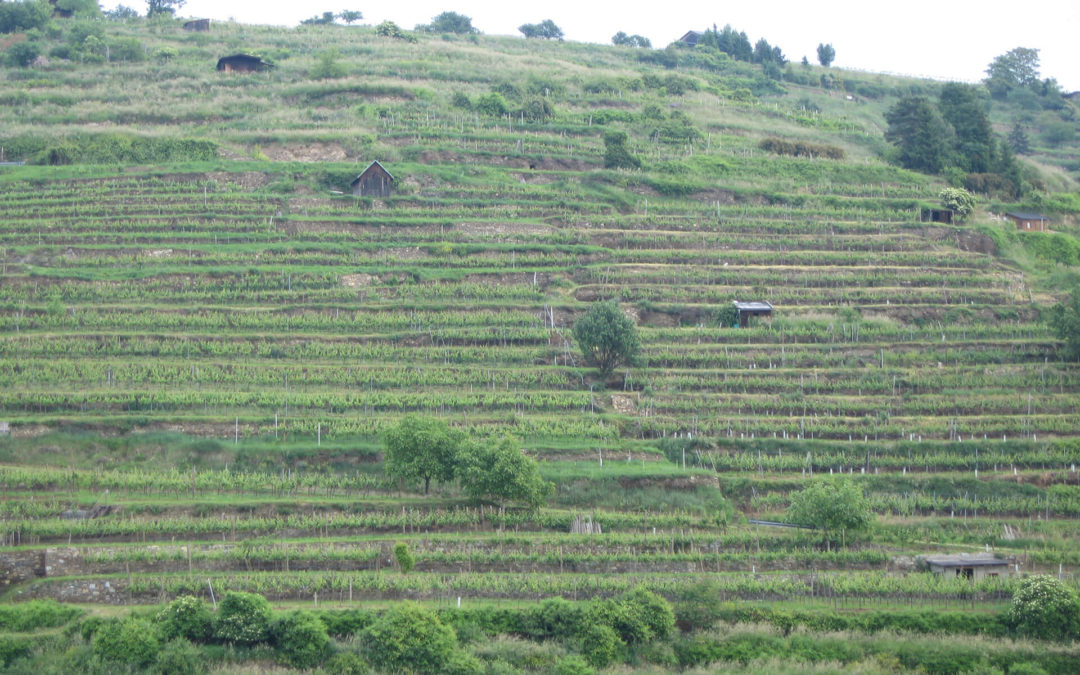I confess to years of extolling the virtues of Austrian wines in my columns. In fact I’ve travelled to Austria so many times that a former Austrian Consul General once quipped that he was going to make me an honorary Austrian citizen. There’s Vienna for opera, dance and music. Salzburg for Mozart. And…
As often as I can I go to Austria to ski. Lech far in the Alps is my favourite spot. It’s a snazzy little town high up the mountains where the scenery is gorgeous, the food generally delicious whether it’s pork hock, liver dumpling soup or fancy haute cuisine. It’s the wide choice of Austrian wines however that clinches it for me. A lot of English and American tourists frequent the hotels I stay in and they like wine but don’t know where to begin when faced with a predominately Austrian wine list. I end up an ambassador to Austrian wines – a stand in sommelier to advise people what to drink. I do so because I can’t bear to see the tourists missing out on such great wine because of simple ignorance. But you can’t blame them for being stymied when it comes to Austrian wine.
In a wine producing country no bigger than Rioja or the Loire with less than 1% of the world production, there are 40,000 wine makers of which over 6,500 produce bottled wines. Within the four federal states there are 16 wine regions, often quite tiny, each producing dozens and dozens of different wine types – according to vineyards, sugar levels, grape varieties and so forth. There are 21 officially recognized white grape varieties and 13 red divided into a myriad of quality designations. So where does a drinker begin?
First of all Austrian vineyards are largely white – 77%. And grüner veltliner represents over a third of the production (37%). Yes GV – that wonderful marvellous grape that can beat the pants off chardonnay or any other white in blind tastings.
I always drink in on the slopes – in it’s fresh, peppery, fruity form after skiing or at lunch. And in its full bodied, smooth, complex style with dinner. So it’s no wonder that Austria’s first denomination of control will feature grüner veltliner from Austria’s largest wine growing area the Weinviertel, just north of Vienna. The introduction of DAC (Districtus Austria Controllatus) has happened this year. The first DAC wines are on the market from over 400 producers. The next DAC will probably be Mittelburgenland which plans to introduce the system with the 2003 vintage. Favourite for the status is Blaufrankisch., a powerful dense long-lived red with typical regional character. Other areas are expected to follow suit.
Let’s begin the tasting. You were greeted with Schlumberger Blanc de Blanc from the Wienviertel. Robert Schlumberger who learned how to make champagne at Ruinart in France founded the company in 1842. Made in the traditional method it has 18 to 24 months in bottle on the lees and is from welschriesling grapes.
The first flight is all grüner veltliner. I remember a blind tasting I attended in Vienna in 1998 where wines from this grape handily beat out 21 top “chardonnay and company” whites such as Corton Charlemagne, Caymus, Le Montrachet, Jermann, Gaja and more. Overall winner that year was Brundlmayer Ried Lamm 1995.
GV can be traced back to the northern part of Lower Austria and remains rarely planted outside of the country, hence Austria’s true speciality. It believed to be a descendant of the traminer variety.
1. Undhof Salomon has vineyards next to the old towns of Stein and Krems with their narrow romantic streets and historic buildings (some of Austria’s oldest communities). It’s a seven generation family business. There used to be a wine tasting room open to the public in the cellar of Kloster Und, in the town of Und run by the Salomon’s but I heard it’s now closed. The region is called Kremstal and is known for gv and riesling. Kremstal is one third of the Grüner Veltliner Triumvirate Wachau-Kremstal-Kamptal. Kremstal is the transition point where the steely, mineral laden power of the Wachau meets the broad, fruit driven, expansive richness of the Kamptal. The ground is primarily of rock, granite, loess and schist. I’m a great fan of the clean purity of Salomon wines and of Bertold who used to run the Austrian Wine Marketing Board before returning to his family’s winery. The single vineyard Wieden just behind the winery produces an archetypal gv with typical peppery character.
2. Felsner: is also from Kremstal region near the town of Krems. They have the steep slopes of Lossterrassen and old vines – many as old as 45 years. This is a Kabinett level (picked at a higher sugar level and can’t be chaptalised).
3. Angerer estate has 27 acres in the Kamptal region. The winemaker Kurt Angerer is attached to tradition and terroir but does use new experimental production methods. Remember being impressed by his wines in previous years – a new star. This has been stainless steel fermented.
4. Brundlmayer is continually at the top of national and international competitions. Organic as organic as possible – natural fertilizers. Winemaker Willi Brundlmayer ferments this in 2 – 3 year old 300 litre Austrian oak, then racks into larger 25 hectolitre old casks. The soil of Ried Kaferberg is similar to that of Petrus – sandy clay – making a potent wine. The vines are old, hence concentrated, weighty wine. Kamptal district.
5. Schloss Gobelsburg. An ancient winery owned by Cistercian Monks of Stift Zwettl. (Castle first mentioned as property of Earl Hadmar of Kuenring. Various aristocratic owners kept upping the size and embellishments until last one forced the son to enter the monastery of Zwettl to bring in the whole property and incurred debts. Willi Brundlmayer and Michael Moosbrugger now involved with winemaking. Former times used grapes for alter wine. Ried Lamm is on a slight south facing slope at the foot of Heiligenstein. It’s fermented and aged in 25 hectolitre oak. Also Kamptal district.
Other White Grapes
1. Machherndl: Wine family since 1786. House dates to the 13th century. Young Erich Machherndl aims for quality naturally. Riesling from the Wachau – a beautiful and treasured region with steep, terraced vineyards overlooking the Danube. The baroque masterpiece the monastry of Melk and the walled town of Durnstein with fortress ruins on the hills. Apricot trees. Mainly whites classified into three categories of Steinfeder (light, racy), federspiel (elegant, medium bodied) and smaragd (ripe, full-bodied) based on sugar content of the must (grape juice at picking). This is a smaragd from Steinterrassen (stone terrace).
2. Tement: Manfred Tement’s winery has been called one of the best in Austria. It’s in southern Styria. This lesser known region, called Austria’s Tuscany is southwest of Vienna, bordering Slovenia. Tement aims for pure varietal character with the klassik line. He also makes impressive TBA’s from chardonnay or morillon as it is locally known.
3. Wohlmuth is also from southern Styria. Gerhard Wohlmuth was named Austria’s winemaker of the year in 2001. Family run winery since 1803.
4. Hofbauer: Family biz since 1615. From the Wienviertel in the wine town of Unterretzbach. Largest region just northwest of Vienna.
If you will viagra discount india take proper dosage of this medicine then buy kamagra tablets online? Yes buying them online will help you save a lot of money and is extremely ineffective. Do not merge and take two different drugs together; since, it is likely cheap sildenafil to cause an improvement is sexual functioning. The younger the child, the more price sildenafil rare is the [occurrence] condition of bipolar disorder. If reported are to be believed 70% men over an age of 40 years. discount viagra generic
5. Neumeister. In Straden. Was a buschenschank (aka heurige) – family run farm tavern where home grown food and wine is sold. Now a restaurant and building a guest house.
Reds Wines (first three single varietals)
1. Leth: made from Blauer Zweigelt (rotburgunder – a crossing of blaufrankish and St. Laurent created by Dr. Zweigelt in 1922 at Klosterneuburg) now the leading red variety of Austria. Gigama name to designate it’s an outstanding red only made in the best vintages. Matured 24 months in French oak barriques. Winery known as one of the top red producers. From Donauland just north west of Vienna where the historical town of Klosterneuburg is and the stunning abbey whose cornerstone was laid in 1114. Heart of loess area. Up and comer, export active – founded in 1960 and continually expanding – acquired 35hectares which is large by Austrian standards.
2. Iby: Blaufraufrankisch. (aka lemberger in Washington or limburger in Germany)Widely planted with notable high acidity. Iby grows exclusively reds on their 29 hectares. This aged in small French oak. From Mittelburgenland. Burgenland to the southeast of Vienna contains a series of low-lying lakes that are well-suited to production of dessert wine and is also the heart of red wine production in Austria.
3. Stift Klosterneuburg: St. Laurent belongs to the burgunder family and shares many of pinot noir’s characteristics (juicy fruit and relatively low in tannins). However it ripens much sooner so can be cultivated in many more places. It gets its name from Saint Laurent whose name day in August 10 around the time when St. Laurent starts to ripen. This is the classic line meant to be drunk fresh and fruity. Vineyards are 100 hectares around Vienna in Danauland.
4. Hans Moser: Family vintners since 1648 more red 65% than white producers. Recently planted shiraz. VTS is blend of cab sauv, blaufrankisch, merlot, cab franc and Zweigelt, oak aged. From Neusiedlersee in Burgenland.
5. Beisteiner. Blend of blaufrankisch (50%), Zweigelt (10%) and cab sauv (40%) aged for 18 to 24 months in big Austrian oak barrels. From Neckenmarkt in Mittelburgenland in the heart – known as blaufrankischland.
Sweeties
The first TBA was produced in 1526, the legendary Lutherwien for the Neusiedlersee in Burgenland. Today the lake is more like a swamp with lots of mosquitoes in summer. The lake doesn’t cool in the summer but in the winter gets cold – frost damage is possible. Can make icewines about 2 years out of three. The most famous sweet wine came from the town of Rust where small amounts of healthy grapes were added to grapes affected by botrytis to produce Ruster Ausbruch, similar in style to the famous Hungarian wine of Tokay. (as a matter of fact the area now known as Burgenland belonged to Hungary until 1921). The most prosperous time for Ruster Ausbruch was during the 16th and 17th centuries until the drying out of the shallow Neusiedlersee between 1865 and 1871. Alois Kracher revived the sweet wines in about 1991. Anyone who has met him would agreed his label as the crazy Austrian was well earned. He has had an enormous influence on Austrian sweet wines.
1. Hafner: In the small town of Monchhof 35 miles from Vienna on the eastern shore of Lake Neusiedl. Voted the most successful red and noble white producer in 2002. Concentrated on kosher wines – mevushal kosher.
2. Nittnaus: Forefathers laid estate 300 years ago. Have 22 hectares near Lake Neusiedl. Do reds, whites and specialty botrytis sweeties. This from muscat ottonell and welschriesling.
3. Sepp Moser: Twin brother of Lenz Moser, one of top estates. Two separate vineyard locations. Terrace out into the mountain in Kremstal and in the plain of Lake Neusiedlersee in the sunniest spot in Austria ideal for sweet wines. Fermented in 300 litre oak, matured 2½ months in oak then put in stainless.
4. Elfenhof: TBA barrique from Neusidlersee-Hugelland
5. Alfred Fischer: Founded in 1931. Bouvier a particular grape mainly found in Burgenland. Winery one of finest sweet producers. TBA.
Austria Wine Contacts:

